One of the biggest lessons I've learned living in Munich (as someone who grew up in the Southern U.S.) is to make the most of every season. Especially Winter, my area of least expertise. Winter activities like skiing and sledding have been fun, but there was something new we hadn't tried yet. It's an activity that dates to at least the 16th Century, has European and World championships, and has been "demonstrated" at the Winter Olympics two times. It's called eissstockschiessen.
Below, you see the Nymphenburg Palace and a worker preparing the ice for eisstockschiessen and skating.
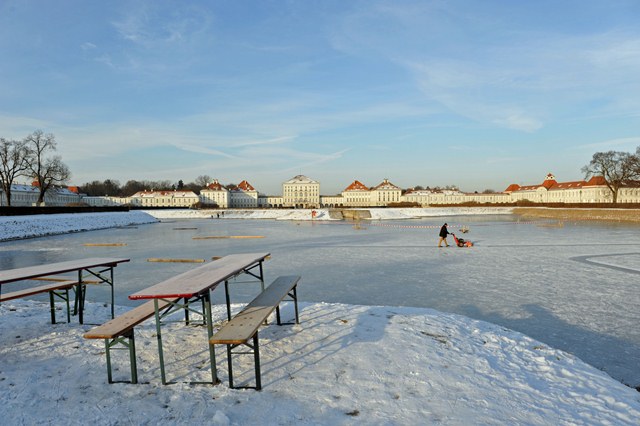
We'd wanted to try eisstockschiessen before, but somehow never made it in the last years. It needs to be consistently cold so the water freezes to a safe thickness - at the mercy of nature, lanes open and close with little warning. There are lanes all over the city, but the ones on the Nymphenburger Kanal (near the Nymphenburg Palace and Gardens) are the most popular. They have the capacity for 40 lanes (marked by the end boards on the ice) from the castle all the way to the bridge where the local tram stops.
Here is a view down the canal:
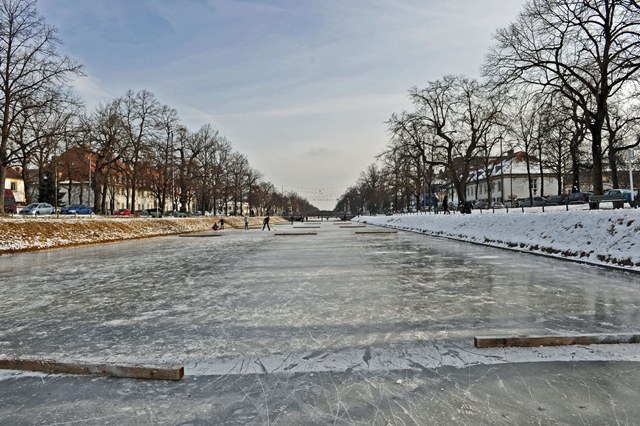
Since the temperature had averaged -10°C for the previous two weeks, we checked online and the lanes were open. Not knowing how crowded it gets on weekends, we called ahead and reserved one at 9am. We arrived a little late (9:15) but the rental shack was closed and the one person who seemed associated with it was out on the canal ice, driving a mini Zamboni to clear the lanes (see this in the first photo above). That is not very German (imprecise!), so we killed some time taking photos of the palace.
After 30 minutes and no indications that he would be finished soon, we ducked into a cute little corner cafe and warmed up with cappuccino, a krapfen (filled doughnut) and piece of marmorkuchen (marble loaf cake).
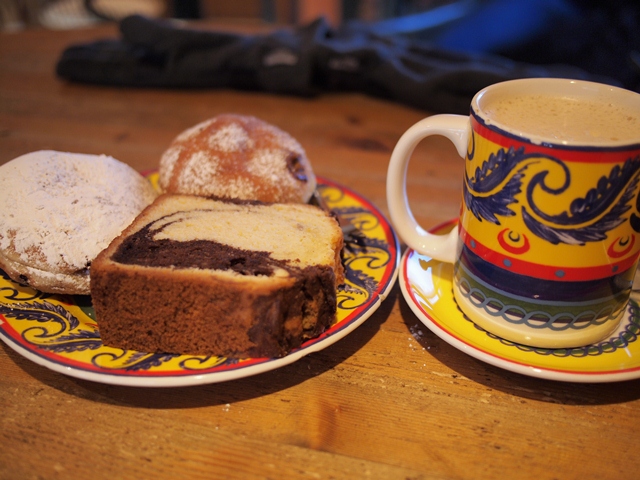
Now fuelled up and with full feeling in hands and face again, we headed back to see if we could rent the equipment and get our lane. The trailer was finally open for business. A lane costs €4 per person, for 4 hours - very reasonable.
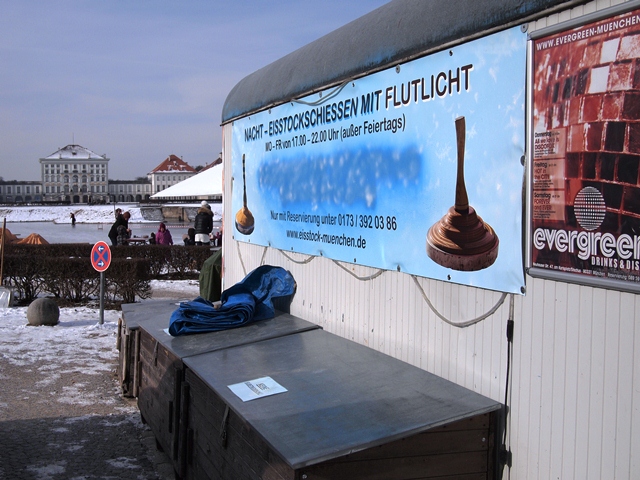
Required equipment includes the Eisstöcke (plural of Eisstock) to toss/slide (like the "stone" in Canadian curling) and the Dauben (targets). The kanal lanes include end boards to contain throws that would send an Eisstock into the next lane. We saw many people come later (we were still the first that cold morning) with their own sets of Eisstöcke and Dauben - serious players indeed. Theirs were often bright metal, whereas the rental Eisstöcke are wooden (but good enough for us!). The rental Dauben were simply rectangular blocks of wood dusted with orange paint.
Here is Frau A showing the bottom of a stock.
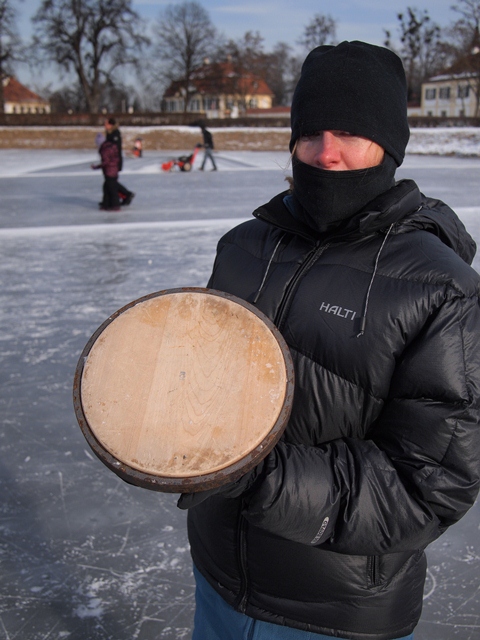
The game is a lot like bocce or shuffleboard. The goal is to slide your Eisstock closest to the Daube. It's a great group activity -- especially the arguing about who is closest and the fun of knocking someone else's Eisstock away.
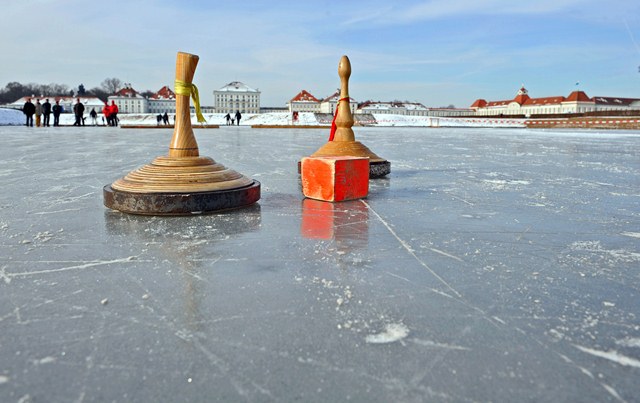
We played 1-on-1 this morning, but it's usually played with 2 teams of 4 people. This means that in each round, 8 Eisstöcke are thrown. The points are tallied at the end, and the next round starts from the other end of the lane. Usually the team that captured the most points on the prior round goes first, so the other team has the last chance this time to knock their Eisstock away from the Daube and score the points.
There are official rules to the game, since it is played competitively (and internationally). However, most people tend to have their own variation on the rules. For example:
First to 10:
In each round, the team with the Eisstock closest to the Daube receives 1 point. First team to 10 points wins.
Quick First to 10:
In each round, the team with the Eisstock closest to the Daube receives 1 point. If that same team also has the Eisstock that is second-closest to the Daube, they receive 2 points.
4 Rounds:
There are only 4 rounds, and the team with the most points at the end wins. In this case, the scoring is like in Quick First to 10 but not limited to 2 points. A team can receive up to 4 points (if all 4 of their Eisstöcke were closer than the opponents' closest one).
6 Rounds:
There are only 6 rounds, and the team with the most points wins. The closest Eisstock receives 3 points, and for each other Eisstock that is still closer than the opponents' closest toss, the team receives 2 points (up to 9). This is usually part of tournament play, so that a win after 6 Rounds gives a team 2 points (a draw 1, and a loss 0). Then teams move on to other competitors for the next games.
The official rules are, of course, much more precise and include a target area around the Daube. Only Eisstöcke within the target can get points, and the Daube can only be struck and moved within the target area (if it is pushed outside the target area, it is brought back to its position before the contact).
We took a video... I had to swing as hard as I could to toss the Eisstock, staying relatively low on the ice so not to fall! We saw many Germans who wore strap-on spikes while they played for stability.
Here are some of those more experienced players on the lane next to us. You can seel ice skaters taking advantage of the open space at the end of the eisstockschiessen lanes. (The shack rents ice skates too.) And again, the nice view with the Nymphenburg palace in the background.
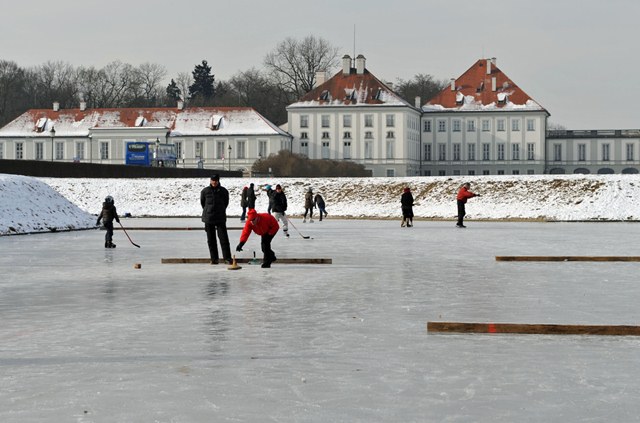
They were pretty serious, and brought out the measuring tape a few times to settle a debate (we were too slow with the camera, unfortunately).
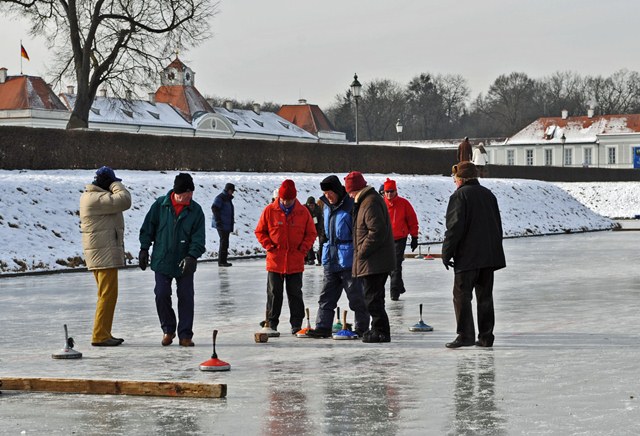
As with most Winter activities here, the proper way to finish is with a hot mug of glühwein (mulled wine). The shack was happy to sell this too, but oddly theirs included raspberries. This is unusual, but tasted nice -- although most raspberries ended up tossed onto the snow.
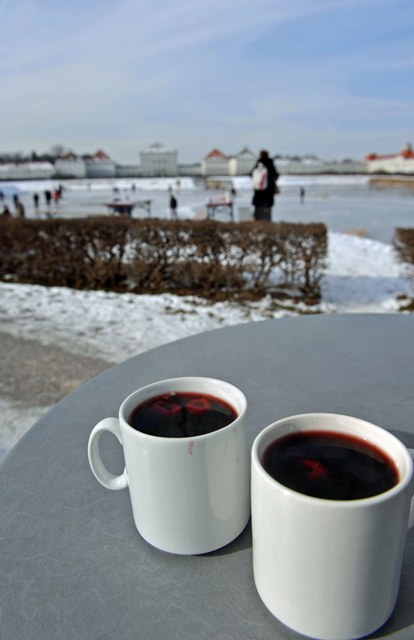
When we returned, we looked up the weather. No wonder we were chilled -- it was -15°C at 9am, and the high that day was -10°C.
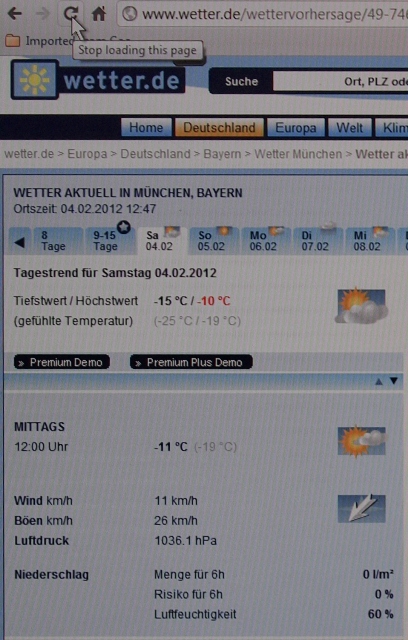
Which explains my attire. Although it isn't easy to move, I recommend (for warm weather people like me) as many layers as you can manage. After thermal underwear, fleece leggings, 2 fleeces undercoat, and a down jacket, I added Herr J's balaclava to protect my face. (And you can't see the handwarmers inside my gloves.) Yes, I'm slowly learning to deal with Winter, but Herr J will usually carry extra handwarmers just in case...
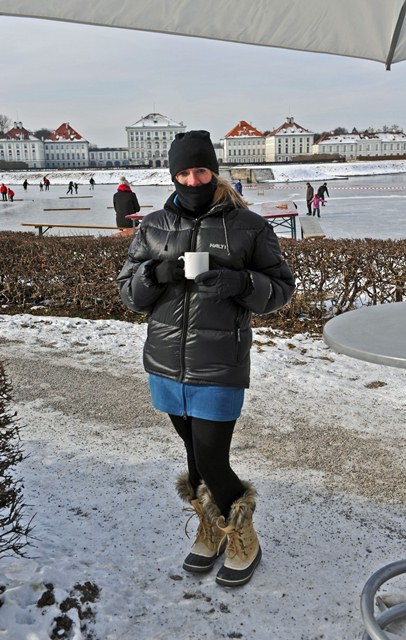
The ice has mostly melted now, but fortunately we returned the following weekend with a friend to get in a few more games that season. We're looking forward to more next year. (Or maybe we should try the Summer version!)